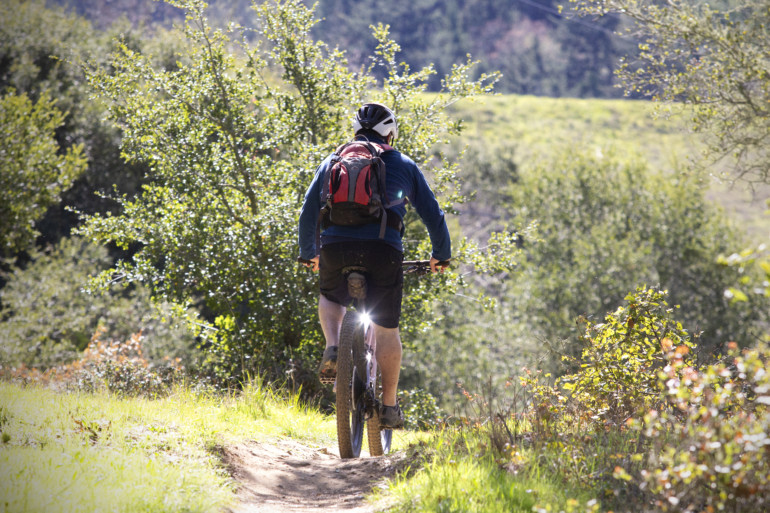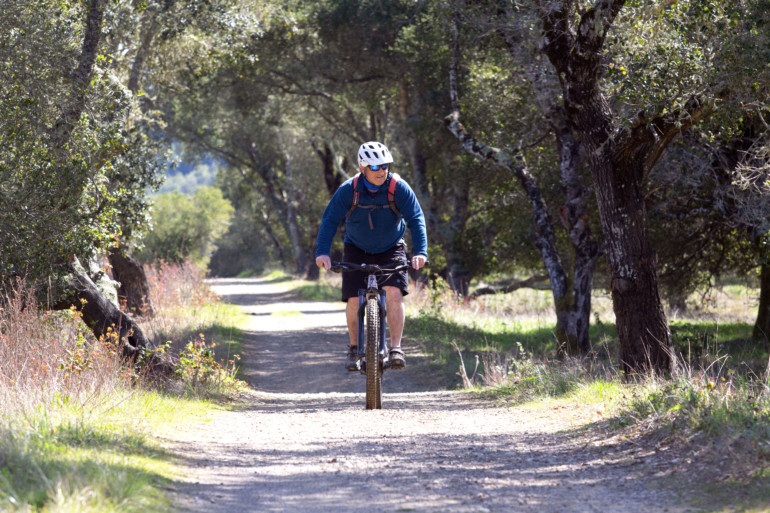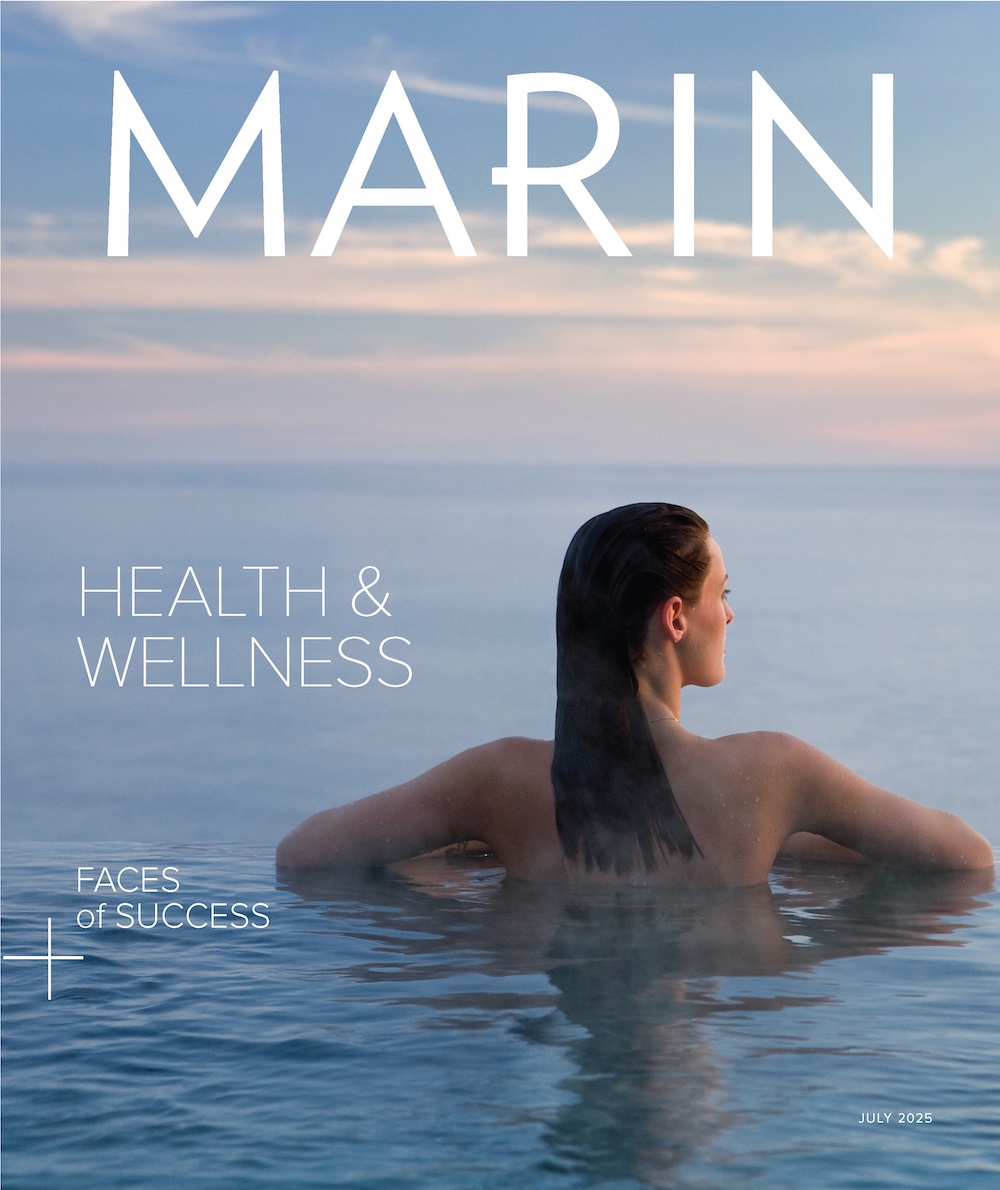I was riding my new high-tech, pedal-assist mountain bike (also known as an e-mountain bike or e-MTB), up a winding, steep dirt fire road in the Marin headlands. It seemed apropos that my bike’s maiden run was here in Marin, the birthplace of mountain biking. In the 1970s, sturdy, fat-tired bikes with innovative, custom-built frames were created by a few local cycling enthusiasts like Joe Breeze and Charlie Kelly, who raced the bikes on the dirt roads of Mt. Tamalpais’ watershed.
To my amazement, I ascended almost effortlessly over rugged, rocky terrain and past a few traditional mountain bikers grinding up the steeps. As I pedaled steadily, I felt propelled by an invisible force, a phantom tailwind generated by a small battery and quiet electric motor deftly hidden in the bike’s frame. It felt almost magical, like a Disney ride with a bit of cardio thrown in for good measure. Instead of straining my lungs and legs, I was cruising along and, honestly, having the most fun I’ve had on a bike in a lifetime of bike riding. It was still a workout, but relaxing and scenic as well. Now, after six months of steady riding, my e-MTB has completely redefined my Marin mountain biking landscape, bringing me to wondrous terrain and scenic spots that I haven’t cycled to in years.

My e-mountain bike, a svelte, clay gray Specialized Turbo Levo, is a “Class 1” e-bike, whose motor assists only when the rider is pedaling and ceases when the bicycle reaches 20 mph. This is the type of e-bike most commonly approved for use on paved and dirt public trails and roads. Class 2 e-bikes are equipped with a motor and throttle used exclusively to propel the bicycle, and also cuts out when the bicycle reaches 20 mph. Class 3 e-bikes are equipped with a motor that assists only when the rider is pedaling, stopping when the bicycle reaches the speed of 28 mph.
Brett Thurber is the founder and co-owner of The New Wheel, an e-bike shop he founded a decade ago in San Francisco followed by Larkspur location, which opened in 2016. “Electric mountain bikes began to boom around three years ago. The initial boom started because the technology had gotten so good, but the pandemic lit a fire under it, as it turns out the electric mountain bike is the perfect outdoor escape from lockdown fatigue.”
Joe Buckley, a lead e-bike developer at California-based Specialized Bicycles, provided additional insight: “We believe the electric mountain bike is a natural evolution of the current one, as it provides riders the power to ride more trails. What may have seemed niche a few years ago has quickly become mainstream and is now widely accepted. The ride delivers an experience that mimics the handling and feeling of a traditional bike, except now you have superhero legs.”
Superhero legs? That works for me! My dual suspension, aluminum frame Specialized Turbo Levo rides like a mountain goat, thanks to geometry based on their highly successful Stumpjumper mountain bike. Designed in the Swiss Alps, my bike is relatively heavy (48 pounds) but you don’t really notice it when riding, unless you run out of battery power and the bike becomes a sluggish beast. There are three levels of power assist you can adjust on the fly and also customize with a proprietary Specialized Mission Control app on your phone. Typically, the battery lasts several hours on one charge.
While e-mountain bikes have been a godsend for older riders whose legs suddenly feel like they are 20 years stronger, there are increasing numbers of younger, more sporty mountain bikers who ride a sub-class of less-powerful but lightweight Class 1 e-mountain bikes to tackle longer, more challenging rides more frequently and further into the outdoors. This is attracting more traditional bikers into the sport of e-mountain biking, but there is occasional resistance — usually in the form of a snippy comment or glare on uphill stretches of trail.
Specialized Bicycle’s Buckley says: “In our eyes, if you ride your bike on the dirt or on the mountain, you are a mountain biker. The tool you wish to use is simply an extension of your style and riding choice. In the past, electric assist was associated with “cheating,” which we know is an ego-fed argument and unless you’re racing, this attitude has no place in the mountain bike community. What really matters is how you ride and if you are respectful on and off the trail. We encourage community building and inclusivity, motor or not.”
Buckley adds, “We believe to our core that bicycles have the power to change lives. Electric bikes of all varieties are opening doors for both new and existing riders alike. We believe this is a good thing.”
Mountain bike pioneer Joe Breeze, who now curates the collection at the Marin Museum of Bicycling/Mountain Bike Hall of Fame in Fairfax says, “Many of Marin’s affluent and influential live in the hills, and many aim to be green — but those hills may make them car-reliant. For them, e-bikes are a boon: a viable green vehicle that’s loads of fun. When a bicycle works for their own everyday trips, they see how cycling could work for anyone. I’ve seen it happen: Newfound joy, life enhancement and a whole new, supportive vision of bicycling. When the influential see and feel the potential, progress gets accelerated.”
As a newly minted devotee of e-mountain biking I couldn’t agree more and, every time I ride, I thank my lucky stars these amazing bikes evolved from fat-tired clunkers into the Teslas of the mountain bike world, the latest innovation on the ever-changing bicycle tree of life.
Where to buy e-MTBs in Marin

The New Wheel (Larkspur), Trek Bicycle (Corte Madera) and Mike’s Bikes (San Rafael and Sausalito) offer Marin’s largest selection of e-MTBs, including bikes from Specialized, Santa Cruz, Trek and Riese & Müeller. The New Wheel’s Thurber says most e-MTB buyers are “ages 30 to 85 who enjoy the fitness component and are attracted to the ability to take rides beyond what people imagine.”
High-quality bikes are an investment (around $5,000 and up) but Thurber suggests avoiding less expensive brands, which he described as “goofy” and “hodgepodge” and potentially hazardous because cheap batteries can fail and catch fire when charging. He says this pitfall can be avoided by buying e-MTBs equipped with batteries by major manufacturers like LG, Samsung and Panasonic. He says you can expect to replace these batteries every five years and get 600 to 700 full charge cycles per battery.
Especially with the pandemic, E-mountain bikes have been very popular and the supply chain for bike components is tight. You can expect a wait of 45 days or longer to receive your order but most dealers take refundable reservations to make the process easier. Be patient: It’s worth the wait. For me, after decades of mountain biking in Marin, my e-MTB has been a real game changer, a genuine partner in two-wheeled adventure, exercise and fresh air escape. One final bit of advice: Be sure to recharge your bike after each ride — once you’ve been bit by the e-MTB bug, you’ll want to hit the trails everyday!
Where to ride e-MTBs, legally

One major issue that swirls around this relatively new sport is access to dirt roads and trails. Regulations vary widely and are in constant flux as more and more riders appear on the scene. At present, class 1 e-mountain bikes are allowed in most National Parks on dirt and paved roads where bikes are allowed. The Forest Service is making policies but is leaning toward wider access for e-mountain bikes. BLM-managed public lands offer many opportunities for riding e-bikes, including any Open OHV area or motorized trail. For use on non-motorized trails, contact your local BLM office for more information.
E-bikes are allowed on trails limited to bicycles and non-motorized travel only if a BLM Manager has issued a written decision authorizing e-bike use in accordance with applicable laws and regulations. Many state and regional parks have established regulations for these bikes; check the websites of individual parks and other public lands for specific rules and regulations. As with traditional bicycles, e-bikes are not allowed in wilderness areas. The International Mountain Bicycling Association (IMBA) website has current information on access. An advocacy group called People for Bikes publishes an online e-bike map and web-based trail map sites like TrailForks.com have filters for finding e-bike-legal trails.
In Marin, the Golden Gate National Recreational Area (GGNRA) allows e-MTBs on all roads, dirt and paved, where bikes are currently allowed. My favorite dirt road rides in the park’s Headlands often include the Bobcat, Miwok, Marincello, Coyote Ridge and Dias Ridge trails. Point Reyes National Seashore has a number of e-MTB-legal trails as does China Camp State Park (day or annual permit required); both parks offer trails suitable for beginner and intermediate riders. In Fairfax, Scout-owned Camp Tamarancho has an extensive network of challenging single-track trails (day or annual permit required). The crown jewel of Marin mountain bike riding, the Marin Municipal Water District, is considering a proposed three-year trial period allowing Class 1 e-bikes on dirt fire roads where traditional mountain and gravel bikes are currently allowed.
How to help:
Consider supporting one of these local nonprofits that urgently need support during the pandemic.
More from Marin:
- 5 Wildflower Hikes to Try in Marin this February
- Marin’s Best Hiking Loops
- A Not-So-Hidden Treasure on Sausalito’s Hill 88
Ben Davidson is a Bay Area native and spent his early years in Mill Valley. He is a former Sunset staff travel writer and also contributes to Diablo, Westways, VIA and 7×7.com. He has lived in Fairfax since 1997.


